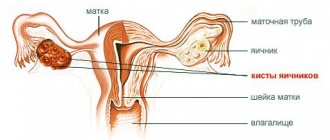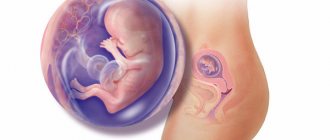Periodic discharge from the genital tract accompanies a woman for almost the entire 9 months of bearing a baby. Some of them are a variant of the norm, others are a signal of a pathological process.
The 40th week of pregnancy is the period when the expectant mother expects the birth of her little one any day now. At this time, many women are especially attentive to their body, paying attention to any changes in their usual state. Vaginal discharge may also change. What does this or that discharge indicate at 40 weeks of pregnancy? What situations require seeking medical help?
Brown discharge
After examination by a gynecologist, many women noticed brown discharge for several hours. At 39 and 40 weeks, when the pregnancy is considered full-term, the doctor examines the cervix to determine its readiness for childbirth. Since at such late stages the structure of the cervix changes, it becomes thinner and looser, and it may be injured during examination. There are no negative consequences in such secretions. On the contrary, it can be assumed that the body is already ready for childbirth.
Discharges that signal problems in the body cannot go unnoticed. If a woman treats her body with care, she will immediately pay attention to changes in the discharge, which will differ in color, have a specific smell and a special consistency.
What happens in a woman's body?
The amount of amniotic fluid decreases, the cervix shortens and becomes looser and softer. Thanks to this, during childbirth it will open enough to give the baby a way out.
Pain in the perineum, legs, and lower back increases. It becomes almost impossible to sleep. Against this background, weakness appears. Often mothers at this stage are already tired of pregnancy and are very concerned that the baby has not yet been born.
In this case, it is important to understand that the absence of labor at 41 weeks does not mean that the pregnancy is post-term.
Changes in a woman’s body at 41 obstetric weeks of pregnancy
Harbingers of childbirth
Every woman begins labor differently. In some cases, when contractions have not yet begun, but other symptoms have appeared.
Signs indicating imminent labor:
- Frequent urination.
- Diarrhea.
- The appearance of amniotic fluid.
- Slight brown discharge.
If regular contractions occur, repeating every 10-15 minutes, the woman can be sure that in the near future.
Chest and abdomen of a woman at 41 weeks of pregnancy
This week, the tummy of almost all mothers noticeably drops, which may make it seem smaller. Nowadays, stretch marks (striae) are likely to appear on the skin. But if a woman tried to keep her skin in good condition before and during pregnancy, it is likely that there will not be a single stretch mark on her tummy.
The breasts may also be susceptible to stretch marks. But now the mother needs to use various cosmetics very carefully, since the baby can be born at any moment and the taste of his first meal should not be spoiled by any creams.
Ideally, moisturizer should be applied to the breasts, avoiding the area around the nipples. The same rule applies after the birth of the baby.
Movements during pregnancy
There is little space left in the abdomen, the amount of amniotic fluid is decreasing, so active movements are a thing of the past. Now mom can count no more than 10 of them a day. However, given the weight of the child, the movements gain strength and can cause severe pain to the pregnant woman.
Video: 41 weeks pregnant
White foamy or curdled discharge
If thrush (Candida fungus) cannot be cured before pregnancy, it can cause inconvenience throughout the entire period: constant itching both outside and inside the genitals, redness, white discharge, mostly profuse. In addition to severe discomfort, there is a more serious reason why you need to get rid of the disease as soon as possible. The mucous membranes inside, exposed to this fungus, lose the necessary elasticity during childbirth. This leads to ruptures in the perineum, which take a very long time to recover. In addition, a child may become infected with thrush during childbirth. White plaque in the mouth, tongue, and groin will cause suffering to the baby. Thrush in some cases is very difficult to treat. Especially during pregnancy, when immunity is reduced. If it is not possible to get rid of it before birth, sanitation of the birth canal will be carried out before birth.
What to do if contractions don’t start?
It depends on each specific situation. If there is no threat to the baby, the pregnancy may continue. In this case, to stimulate labor, women are recommended:
- (before the mucous plug comes out, after it comes out, sex is not recommended to avoid infection of the fetus);
- nipple stimulation;
- , going up and down stairs;
- castor oil in a small amount (a few drops) orally to stimulate intestinal motility, which causes uterine contractions.
In some cases (with immaturity of the cervix), during full-term pregnancy (at 40-41 weeks), one of the antigestagenic agents (Mifepristone, Miropriston, Genele, Ginestril) at a dose of 200 mg/day can be prescribed to induce labor activity, taken every other day medications are repeated in the same dose. 3 days after taking the first tablet, the doctor assesses the condition of the birth canal.
If stimulation does not help, a decision may be made to perform operative delivery. If the waters have broken, but labor has not begun, you need to get to the maternity hospital as early as possible so that doctors can find out the reason for the early rupture of waters and take measures to successfully resolve the birth.
Yellow discharge
The third trimester is no exception for the appearance of various infections in the body. Yellow discharge indicates a high concentration of leukocytes. And accordingly, about infection. Inflammation of the genitourinary system can harm the child. As the mother's body's defenses weaken, there is a threat of infection to the fetus. Especially after the plug comes out and during childbirth. Green discharge combined with an unpleasant odor (rot, rotten fish) indicates the appearance of sexually transmitted infections (chlamydia, gonorrhea, trichomonas). Only a gynecologist who knows all the nuances of your pregnancy can prescribe the correct treatment.
If you suspect leakage of amniotic fluid, or the water has broken at home, pay attention to its color. The yellow color of the water is an indicator of increased fetal bilirubin, and green indicates hypoxia. When entering the maternity hospital, you must inform the doctor about the color of the water so that he can choose the right tactics for labor.
What can and cannot be done for a woman during pregnancy?
If doctors have confirmed that the baby is ready for birth, simple physical exercises can be very useful for the mother. This way, labor can occur faster. In this regard, walking quickly up the stairs, washing floors, and, oddly enough, sex is not encouraged.
Only if by this time the mucus plug has already moved away, sexual intercourse must be protected.
You should definitely visit an antenatal clinic and completely trust your doctor. You should not refuse hospitalization - at this stage it is more of a necessity rather than a recommendation.
To relieve psychological stress, mommy should take walks more often, but it will be safer if these walks are close to home. By this time, all the necessary things should be packed in the bag.
When compiling a list of necessary things for the maternity hospital, it would be a good idea to ask the medical staff about what exactly you need to have with you.
41 weeks of pregnancy - how to understand that everything is fine?
Perhaps the most clear evidence that pregnancy is proceeding normally is the constant movement of the baby in the stomach. Now they are no longer so frequent, but the mother should feel them well. Also, the absence of problems is indicated by normal discharge, enlarged mammary glands and regular training contractions.
Brown discharge
Brown discharge is always an indicator of traces of blood. If they appeared after the examination, then there is nothing to worry about. But in some cases they may indicate a problem. Untreated cervical erosion may regularly manifest itself as spotting. At 39 weeks of pregnancy, brown discharge may indicate detachment of a normally located placenta. During abruption, the vessels and capillaries of the placenta rupture, causing bleeding. With minor damage, spotting brown discharge will be observed. With more extensive detachment, bleeding may begin. And this is a complication during childbirth for both the woman and the child. Therefore, in the last weeks of pregnancy, you should immediately report your observations to your doctor.
Feelings of a woman at 41 weeks
Often women complain that by the 41st week of pregnancy the stomach becomes stone at night, but there are no other sensations. If a woman is young and primiparous, this is not a threatening sign. She can give birth on her own by the end of 42 weeks. If a woman becomes pregnant after the age of 35, then such sensations may be a sign of weakness of the birth canal. In this case, she will be recommended to undergo stimulation or delivery by caesarean section. Usually, if a doctor notices signs of weakness of the birth canal, he gives a referral to the maternity hospital. And the specialists who will deliver the baby are already taking steps towards a successful delivery.
If by the 41st week of pregnancy a woman feels discomfort in her legs, pulls in her lower abdomen, as during menstruation, and her lower back ache, this is a sure sign of impending labor. The first contractions are usually not perceived as such. There are simply unpleasant sensations similar to PMS, but more intense.
If you feel like this, it’s time to pack your bag for the maternity hospital. There is no need to rush, because for primiparous women, from the moment of regular noticeable contractions every 20 minutes until delivery, about 10-11 hours will pass. For multiparous women, this period is slightly shorter, 7-9 hours. But it’s time to go to the maternity ward. There are two cases where you should hurry:
- if contractions become more frequent (there is a risk of rapid labor);
- amniotic fluid has broken.
Pain in the lower abdomen at this stage does not always indicate the onset of labor. Sometimes this is intestinal colic (if a woman has digestive problems and constipation, you can think about this reason), inflammation of the reproductive organs, or placental abruption. In the latter case, in addition to pain, the woman may experience bleeding.
Pink discharge
At 39 or 40 weeks the plug usually comes off, sometimes mixed with blood. Therefore, the cork may have a pinkish tint. In all other cases, the pink color indicates some kind of problem with the reproductive system. Cervical erosion can appear after examination of the vaginal organs, as well as after sexual intercourse. Microcracks begin to bleed, turning the clear or whitish vaginal secretion pink. This occurs throughout pregnancy after any mechanical impact. Problems with the placenta can also manifest themselves with pink discharge, especially at the initial stage. A pale pink tint may indicate leakage of amniotic fluid as a result of a crack or rupture of the membranes.
What kind of discharge may bother you at 40 weeks of pregnancy?
How to distinguish physiological secretions from secretions during pathological processes?
Brown discharge at 40 weeks of pregnancy
Normally, labor can begin at any time after the 38th week of pregnancy. That is why the appearance of brown discharge on the eve of PDP often indicates the approach of labor. Discharge may appear several hours or several days before birth. The appearance of a bloody brown “smudge” most often indicates the maturity of the cervix and its readiness to open. Often, discharge of a similar color accompanies the release of a mucus plug. Some time after examining the pregnant woman in the gynecological chair, it is also possible that a brown “smudge” may appear from the genital tract. It is important to monitor the general condition and the presence of accompanying symptoms. The brown secretion should not have an unpleasant odor.
40 weeks pregnant: pink discharge
The appearance of pink (not to be confused with scarlet!) discharge after the 38th week of gestation is more often the norm than a pathology. A secretion of this color often accompanies the release of a cervical plug. The mucus may be completely pink or have pink streaks. The amount of discharge can be moderate or quite heavy. The pale pink color of the secretion is normal if it does not contain an admixture of scarlet blood. An increase in the intensity of the red tint of the discharge indicates the need to urgently contact a medical facility.
Bloody discharge at 40 weeks of pregnancy
As the due date approaches, a woman’s body is actively preparing for the birth of a new life. Brown discharge, as well as the presence of bloody streaks in the clear secretion, is most often a normal variant. At the same time, the discharge of scarlet blood from a woman’s genital tract, even on the eve of PDR, is a dangerous symptom that requires immediate attention to a medical facility. The appearance of bleeding may indicate placental abruption. This condition primarily threatens the life of the child - placental rejection leads to fetal hypoxia; if the area of detachment is large, the baby’s death can occur within a matter of minutes. The appearance of bloody discharge in the 40th week also threatens the woman herself. Opening bleeding threatens the expectant mother with a large loss of blood. In this case, the location of the placenta (normal or low) does not matter. The appearance of red blood in any quantity is a direct indication for going to the hospital.
40 weeks pregnant: white discharge
A white liquid secretion is normal if the pregnant woman’s smears are clean and the woman herself does not experience discomfort. Shortly before birth, the amount of such discharge may increase. The main reason is hormonal changes occurring in the body of the expectant mother. At the 40th week, abundant white discharge of a very thin, almost watery consistency indicates the imminent onset of labor (up to several hours).
Yellow discharge at 40 weeks of pregnancy
It is normal for natural discharge to turn yellow if the woman does not have any complaints. The appearance of yellow mucus may be a cervical plug. If the yellow discharge is excessively thin and watery, it may be a rupture of the membranes and leakage of water (especially if the liquid has a sweetish odor). In this case, the woman is strongly recommended to visit a gynecologist as soon as possible.
40 weeks pregnant: mucus discharge
Discharge in the form of mucus occurs quite often on the eve of childbirth. This is how the body tells the woman that the cervix is ripening and preparing to open during childbirth. Most often, such discharge is transparent or has a whitish-yellowish tint. The mucus has a viscous, slightly viscous consistency. Most often, a pregnant woman can observe such discharge after urge, when the body moves from a horizontal to a vertical position. If after a few hours the mucus begins to darken, acquiring a brown tint, there are only a few hours left before labor begins.
Clear discharge at 40 weeks of pregnancy
Amniotic fluid reliably protected the little one from the possible negative effects of external factors throughout the entire 9 months of pregnancy. The ideal picture of childbirth involves the rupture of the membranes during labor, thereby facilitating the movement of the baby through the birth canal. In practice, quite often the outpouring of water occurs even before contractions begin. In this case, the amniotic sac may rupture completely or be partially torn. In the latter case, leakage of amniotic fluid will occur, which not every pregnant woman is able to immediately recognize. A distinctive feature of waters from other secretions is their consistency. If thin, watery discharge appears at the 40th week, in the vast majority of cases we are talking about amniotic fluid.
In any case, the outpouring of water indicates the beginning of the birth process. It is important to evaluate the water visually:
- The liquid must be clean and transparent.
- The smell is absent or weak (light sweetish aroma).
- A yellowish-green or brown tint of the liquid is a dangerous sign that may indicate infection of the water, meconium entering the liquid and, as a result, hypoxia of the child.
The water may break even if the cervical plug has not yet left. In this case, the mucus comes out along with the amniotic fluid. Leakage or rupture of amniotic fluid is a reason to go to the hospital.
Bloody issues
During pregnancy, any spotting indicates a serious problem. In the third trimester, this may indicate the onset of premature labor, placental abruption, or placenta previa. In these cases, you need to immediately call an ambulance or go to the hospital yourself. Such bleeding can lead to serious complications during childbirth and even the death of the child.
Pregnancy is a period when treatment of the mother can significantly affect the development of the fetus. In some cases, treatment is possible only after childbirth. Therefore, a woman needs to take care of herself all these months. Better yet, plan your pregnancy and undergo all the necessary examinations the day before. If you suspect any problems in the body, always consult a doctor, do not be afraid to play it safe.
How is the baby doing?
Your baby at 40 weeks of pregnancy also experiences a lot of discomfort. During this period, it is already so large that it occupies the entire space of the uterus. In addition, due to the natural aging of the placenta, the fetus at 40 weeks of pregnancy begins to experience a deficiency of the substances it needs.
During this period, the baby moves little, because he simply has nowhere to turn around. But, nevertheless, tremors should appear regularly. A complete lack of activity or the fact that the baby moves too much are signs of trouble. Perhaps the fetus is suffering from hypoxia and needs help.
Therefore, if the mother notices that the baby is behaving unusually, it is necessary to seek medical help. Doctors will do a CTG and Doppler ultrasound to find out if there are any threats. If complications are detected, treatment will be prescribed or a decision will be made on the need to induce labor.
At the described period, the baby should weigh more than 3 kilograms. However, this indicator is individual. The baby's body has almost completely gotten rid of the original fluff (languto). The skin became smooth and took on a pink tint.









